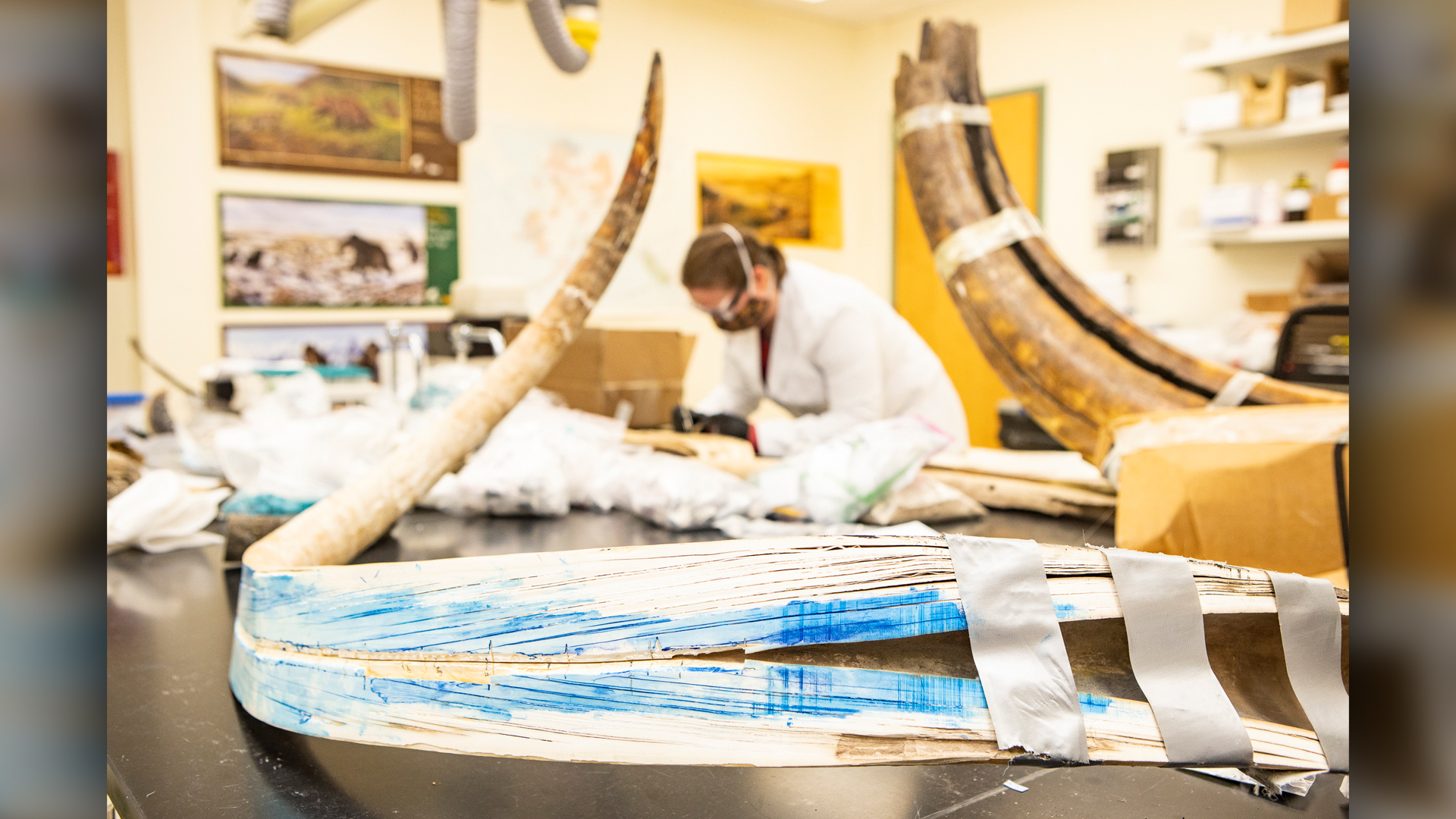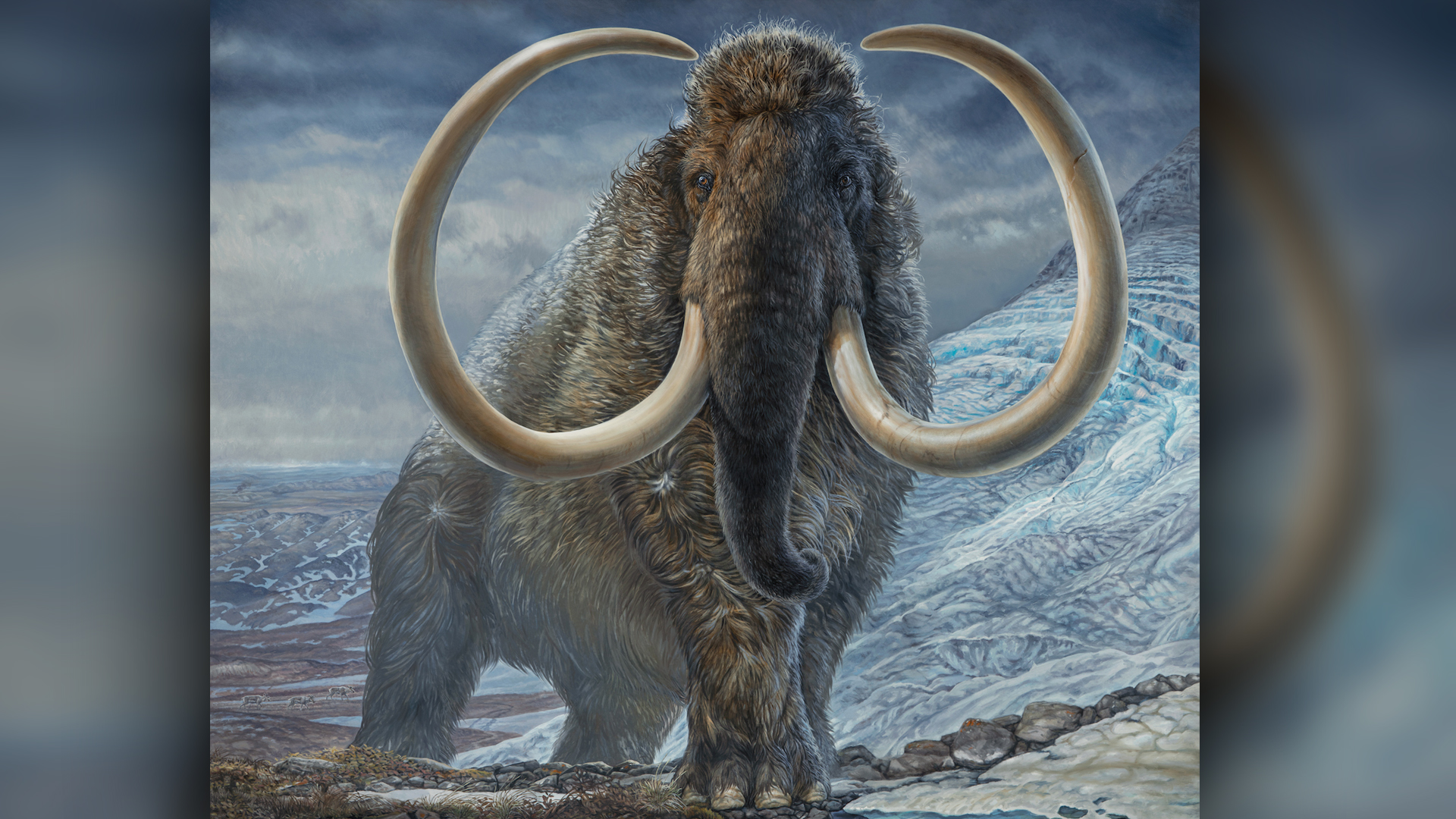Woolly mammoth's epic 50,000-mile journey retraced
A preserved tusk revealed how far the animal ranged during its 28-year lifetime.

A mammoth that lived in Alaska about 17,000 years ago traveled so far and wide that, if it had walked in a straight line, it would have gone all the way around the world — nearly twice.
Recent analysis of the woolly ice age beast's preserved tusk revealed that in 28 years, it walked almost 50,000 miles (80,500 kilometers). To retrace the adult mammoth's steps, researchers did something that had never been done before: They sliced open a mammoth tusk along its length, investigating the chemistry of the layers that built up in the tusk year after year during the animal's lifetime.
Then, they compared that data to chemical signatures in locations across Alaska that were identified from the teeth of small ice age mammals. By matching chemical element ratios in different parts of the tusk to similar ratios from the small-mammal teeth, scientists were able to create a regional map that showed where the mammoth lived from year to year.
Related: Photos: A 40,000-year-old mammoth autopsy
In woolly mammoths (Mammuthus primigenius) and their elephantine relatives (living and extinct), tusks preserve information about their habitats in an element called strontium, which the tusks absorb from plants the animals eat. Ratios of strontium isotopes — versions of the element with different numbers of neutrons — vary between geographic locations, and incremental records of local isotope ratios in tusks can reveal where the animals were dining during different stages of their lives, researchers reported in a new study.
However, most prior analyses of mammoth tusks relied on short cores drilled vertically from tusks. Those cores reveal some of the tusk layers, "but you're not getting the whole record," said study lead author Matthew Wooller, director of the Alaska Stable Isotope Facility and the Water and Environmental Research Center at the University of Alaska Fairbanks (UAF), and a professor in the UAF College of Fisheries and Ocean Sciences.
At the base of a mammoth's tusks are cone-shaped cavities coated by enamel layers that resemble inverted ice cream cones, Wooller told Live Science. New layers coat this cavity every day, and over years and decades, tusks grow longer as new layers build up from the bottom, much as a tower of ice cream cones gets taller if you keep inserting new cones into the open end of the stack. Reading the record of a mammoth's life from infancy to death therefore required splitting a tusk lengthwise, so that all the internal "ice cream cone" layers would then be exposed for sampling, Wooller explained.
Get the world’s most fascinating discoveries delivered straight to your inbox.
Six scientists, one band saw
For the study, the scientists used one of the tusks of an adult mammoth in the collection of the University of Alaska Museum, collected on Alaska's Arctic Coastal Plain above the Arctic Circle in 2010. DNA analysis revealed that the mammoth was male; it lived about 17,000 years ago and its tusk measured 7.9 feet (2.4 meters) long. Figuring out how to bisect the enormous, spiraling tusk evenly (and without damaging it) took the researchers about a year, and splitting the tusk ultimately required six people, an enormous band saw and nearly an entire day of very, very careful cutting, Wooller said.
"We may have broken a blade or two along the way," he said.
After splitting the tusk, the scientists collected about 400,000 individual data points on the concentrations of strontium and other isotopes, such as oxygen and nitrogen, taken from the center of the preserved "timeline" covering the animal's entire life span. The tip of the tusk represented the mammoth as a baby and juvenile, and the base of the tusk showed the last years of the mammoth's life.
To know where, exactly, the mammoth had been walking, the study authors compared their data to a map of the same isotopes for the mammoth's Arctic habitats, preserved in the teeth of tiny plant-eating rodents from the Pleistocene epoch (2.6 million to about 11,700 years ago). Because small rodents like shrews and voles remain in very localized habitats throughout their lives, the regional data could then be used to identify locales where the mammoth lived or visited.
The scientists then generated mammoth "walks" that spanned 28 years and contained 1,133 data points, called "steps," with 40 steps representing approximately one year of life.
Step by step
As a baby, the mammoth lived mostly in the lower Yukon River basin. During the mammoth's juvenile years, it moved into the lowlands of interior Alaska, probably traveling with a herd, where it stayed until it was about 15 years old. The mammoth's range broadened as it reached sexual maturity at age 15 and left the herd, as young male elephants also do, according to the study.
And then, during its last two years of life, the mammoth stayed at higher elevations, in the western end of Alaska's Brooks Range. A spike in nitrogen isotopes before the animal died hinted at a period of starvation, perhaps because of an exceptionally harsh winter, the researchers reported.
"Until this point, we didn't have this level of detail about the movement patterns of mammoths at all," Wooller said. Future studies of other mammoth tusks could fill in even more details about their travels, including how their migration behavior may have changed as the last ice age waned and Earth's climate became wetter and warmer — a challenge that large animals in Alaska are confronting right now, Wooller added.
"Megafauna that are living in the Arctic today are actually facing very substantial and significant climate change," he said. "I think it shines a light on concerns of how all those animals will adapt their behavior in response to very unprecedented changes that we're seeing in the Arctic today."
The findings were published Aug. 12 in the journal Science.
Originally published on Live Science.

Mindy Weisberger is a science journalist and author of "Rise of the Zombie Bugs: The Surprising Science of Parasitic Mind-Control" (Hopkins Press). She formerly edited for Scholastic and was a channel editor and senior writer for Live Science. She has reported on general science, covering climate change, paleontology, biology and space. Mindy studied film at Columbia University; prior to LS, she produced, wrote and directed media for the American Museum of Natural History in NYC. Her videos about dinosaurs, astrophysics, biodiversity and evolution appear in museums and science centers worldwide, earning awards such as the CINE Golden Eagle and the Communicator Award of Excellence. Her writing has also appeared in Scientific American, The Washington Post, How It Works Magazine and CNN.




